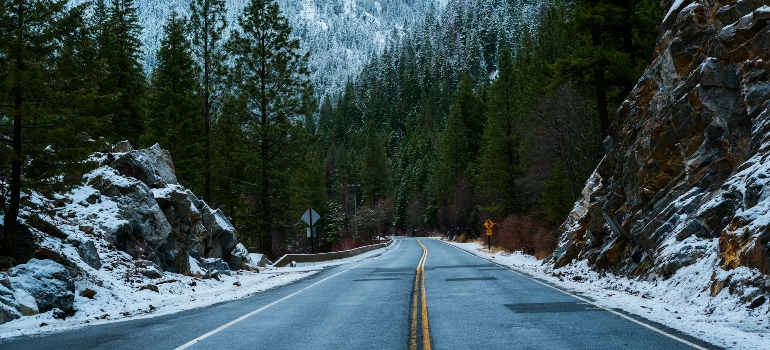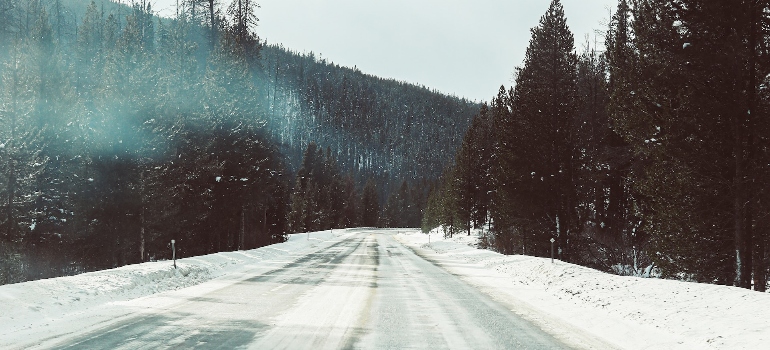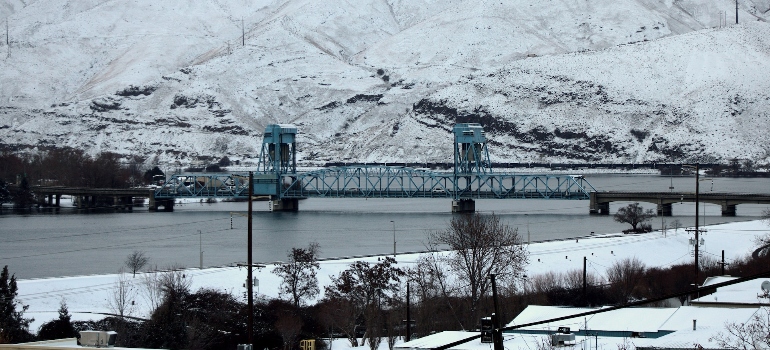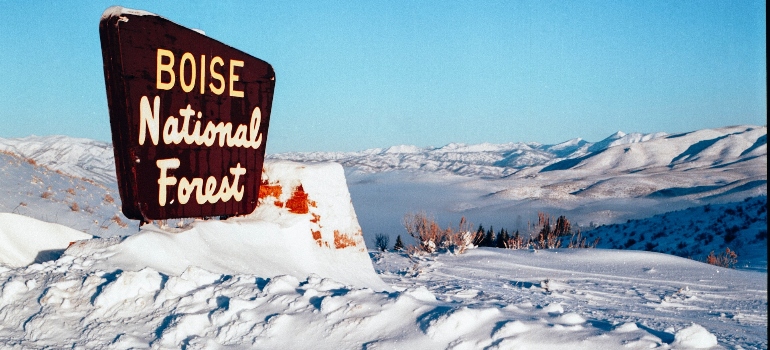Navigating Snow During Idaho Relocation
Winter in Idaho presents a distinctive landscape marked by crisp air and snow-covered vistas. For newcomers, this season demands a strategic approach. While offering scenic beauty, navigating snow during Idaho relocation brings challenges that require careful preparation and adaptability. Hence, this time, our experts from one of the best Idaho moving companies aim to equip those relocating to Gem State with essential knowledge and practical tips for navigating the snowy months. Between safeguarding your home against the chill and mastering winter driving, our guide provides a roadmap for a smooth transition into Idaho’s coldest season, ensuring your first winter is as safe as it is memorable.
Understanding Idaho’s Winter Weather
Idaho’s winter weather is as diverse as its landscape, ranging from moderate cold in the Snake River Plain to severe snowfall in the mountainous regions. This variability is crucial for newcomers to understand. Heavy snowfall is common in the northern parts, like Coeur d’Alene and Sandpoint, often leading to significant accumulations that can impact daily life. The central mountains, including popular areas like Sun Valley, experience a colder, alpine climate, making them ideal for winter sports but also posing challenges in accessibility and daily commuting.
Conversely, the southern regions, such as Boise, experience milder winters. However, even here, occasional snowstorms and freezing nights are not uncommon. These variations are not just geographical but also temporal. Idaho winters can start as early as October and extend into April, with the coldest months typically being December through February.
Understanding these patterns is vital for effective planning. It influences everything from the type of home heating needed to the winter clothing choice. Moreover, it impacts travel plans when moving to Idaho, as road conditions vary greatly across the state. Awareness of local weather trends and regular consultation with forecasts have become essential for safely navigating snow during Idaho relocation. Also, this knowledge prepares one for the practical aspects of winter and opens up opportunities to enjoy the season’s unique recreational activities.

Preparing Your Home for Idaho Winters
Winterizing your home in Idaho is critical in ensuring comfort and safety during the colder months. The process begins with a thorough inspection of insulation. Proper insulation not only retains heat but also reduces energy costs significantly. Pay special attention to areas like attics, basements, and crawl spaces, as these are common sites for heat loss. Weather stripping and caulking around windows and doors are simple yet effective measures to prevent cold drafts.
The integrity of your heating system is paramount. An annual inspection by a professional is advisable to ensure that your furnace or heating system is operating efficiently and safely. This is also the time to replace filters and clear vents or ducts to optimize heat distribution throughout the home.
Pipes are particularly vulnerable to freezing temperatures. Insulating exposed pipes can prevent costly and inconvenient burst pipes, especially those along exterior walls or in unheated spaces. Letting faucets drip slightly during extreme cold spells can also prevent freezing. Also, don’t overlook roof inspection. The weight of snow accumulation can cause structural damage. Ensure that your roof is in good condition and that gutters are clear to facilitate melting snow and prevent ice dams.
Winter Driving in Idaho: Essential Tips
Navigating Idaho’s roads in winter demands a proactive approach to vehicle preparation and driving habits unless you’re booking interstate movers Boise can offer. The state’s diverse terrain, from winding mountain passes to flat, open highways, can present unique challenges under snow and ice conditions. The first step is winterizing your vehicle. This includes ensuring your car has a robust battery, adequate antifreeze levels, and effective heating system functions.
Most crucially, tires must be suited for winter conditions. All-season tires work for lighter snow, but switching to winter or studded tires provides essential traction in areas with heavier snowfall. So, for a safer journey, explore these key winter driving tips:
- Use Headlights: Improve visibility, even during daylight.
- Reduce Speed: Slower speeds offer better control on icy roads.
- Stay Calm in Skids: Steer gently in the direction you want to go.
- Keep Emergency Supplies: Include blankets, food, water, and a first-aid kit in your car.
- Avoid Sudden Stops and Starts: Gentle acceleration and deceleration prevent skidding.
- Increase Following Distance: Allow more space between vehicles to account for longer stopping distances.
Equally important is adapting your driving style to winter conditions. Reducing speed and increasing following distances are fundamental. Headlights should be used to improve visibility, even during daylight. In skidding, it’s crucial to remain calm and steer gently in the direction you want to go. Avoid sudden stops and starts, as these can lead to loss of control.

Finally, always keep emergency supplies in your vehicle, including blankets, food, water, and a first-aid kit. These preparations ensure you can respond effectively to unexpected situations while driving in Idaho’s winter conditions, making your journey safer and more predictable.
What to Expect on Idaho’s Roads?
In Idaho, winter road conditions can vary dramatically, making navigation a task that requires both knowledge and flexibility. The state’s commitment to road safety is evident in its rigorous road maintenance, yet drivers must remain vigilant. In the mountainous regions, snow and ice can persist on roads, creating slippery surfaces that challenge even the most experienced drivers. While less severe, lower elevations can still surprise motorists with sudden snowfall or icy patches.
Understanding the timing and frequency of snowplow operations is crucial. Idaho’s transportation department works tirelessly to clear major highways and routes, but smaller roads may take longer to be serviced. This disparity in road conditions means that travel times can be unpredictable, and routes may need to be adjusted on the fly. Drivers should always have an alternative plan, especially when traversing less populated areas.
Equally important is the awareness of how snow removal affects road conditions. Plowed roads are safer but can still harbor slippery sections, especially near the edges where snow is piled. Additionally, the chemicals and salt used for de-icing can create slushy and uneven surfaces. Drivers need to adjust their speed and vehicle control accordingly, maintaining a heightened sense of awareness. This adaptability and a thorough understanding of Idaho’s diverse winter road conditions are key to safely and successfully navigating snow during Idaho relocation.
Personal Safety and Health During Winter
Winter in Idaho not only transforms the landscape but also necessitates a shift in daily routines, especially when it comes to personal safety and health. The cold months bring risks like frostbite and hypothermia, conditions often underestimated in their severity. Awareness and proper attire are the first lines of defense. Layering clothing is essential; it traps body heat while allowing flexibility to adjust to changing indoor and outdoor temperatures. Key areas such as the head, hands, and feet require special attention, as they are most susceptible to cold injuries.
Beyond clothing, maintaining overall health during winter is vital. The shorter days and reduced sunlight can affect mental well-being, leading to conditions like Seasonal Affective Disorder (SAD). Staying active through indoor exercise or safe outdoor activities can help mitigate these effects. Nutrition also plays a crucial role; a balanced diet rich in vitamins and minerals supports the immune system, which can be vulnerable during cold seasons.

Additionally, indoor and outdoor winter air tends to be drier, affecting respiratory health. Using humidifiers at home and staying hydrated can alleviate these issues. Combining these health and safety strategies, you can endure and thrive during Idaho’s winter months, turning a potentially challenging moving season into an opportunity for robust health and enjoyment.
Emergency Preparedness for Winter Hazards
In Idaho, winter’s beauty is matched by its potential hazards, making emergency preparedness necessary. So, while the local movers in Boise transport your belongings for your family on the road, the key is anticipating and planning for the worst-case scenarios. They include severe snowstorms, power outages, and road closures. A well-stocked emergency kit is essential for every household.
This kit should include items to sustain each family member for several days without electricity or store access. It’s not just about having supplies. It’s about understanding the specific challenges that Idaho’s winters can present and being ready to face them. Therefore, make sure to include the following essential items for your winter emergency kit:
- Water and Non-perishable Food: Enough for several days.
- Battery-Powered or Hand-Crank Radio: To stay updated on weather alerts.
- Flashlights and Extra Batteries: In case of power outages.
- First Aid Kit: Stocked with necessary medications and supplies.
- Warm Clothing and Blankets: To stay warm during power outages.
- Portable Chargers: To keep communication devices powered.
- Extra Cash: In case ATMs and card machines are not working.
Beyond the home, vehicle emergency kits are equally important, especially for those traveling or commuting long distances. These should include blankets, shovels, windshield scraper, tow rope, and cat litter or sand for traction. It’s also wise to keep the vehicle’s gas tank at least half full to avoid fuel line freeze-ups and to ensure mobility in case of sudden weather changes.
Idaho Community Resources and Support
In Idaho, the winter season fosters a sense of community as residents come together to support each other through the challenges of the colder months. This communal spirit is evident in the various resources and support systems available across the state. Local community centers often become hubs of activity, offering warming stations, emergency supplies, and information on navigating snow safely during Idaho relocation. These centers are invaluable for newcomers, providing a space to connect with neighbors and learn from their winter experiences.
Schools and local government offices are pivotal in disseminating information about winter preparedness and available resources. They often organize workshops or send communications on winterizing homes, navigating snow during Idaho relocation, and finding help in emergencies. Libraries also serve as key information points, offering literature on winter survival and programs and activities to keep community members engaged during the long winter months.
Moreover, Idaho’s strong volunteer culture comes to the fore during winter. Volunteer groups coordinate with local authorities to check on the elderly and vulnerable, clear snow for those unable, and provide transportation for essential services. This community support network is a cornerstone of life in Idaho, ensuring that no one has to face the challenges of winter alone. It’s this collective resilience and willingness to help that not only makes winter manageable but also strengthens the bonds within Idaho communities.

Enjoying Idaho’s Winter: Activities and Opportunities
Winter in Idaho, particularly in Boise and the surrounding Treasure Valley, is a time of vibrant community activities and celebrations. It is transforming the cold months after arriving with Boise long distance movers into a season of warmth and festivity. The region comes alive with many events, starting around Thanksgiving and continuing through the New Year.
Boise’s Winter Garden Aglow at the Idaho Botanical Gardens is a must-visit, where thousands of sparkling lights create a magical atmosphere. For those seeking a more active experience, ice skating at The Village at Meridian offers a delightful way to enjoy the season, while the Scentsy Commons Christmas Lights in Meridian presents a dazzling display of holiday spirit.
The holiday season in Boise also features unique events like the Winter Lights Parade and the Boise Holiday Parade, bringing together communities in celebration. For families, Santa’s Wonderland at Bass Pro Shops & Cabela’s and the Santa Claus is Coming to Town event at Boise Towne Square Mall Center Court are delightful experiences for children. Moreover, cultural events like A Charlie Brown Christmas at the Morrison Center add a touch of artistic enjoyment to the season.
These events entertain and foster a sense of community and belonging, essential during the colder months. Festive happenings allow residents and newcomers to engage with the local culture, meet neighbors, and create lasting memories. With its array of activities, Idaho’s winter proves that the season can be as much about community and celebration as it is about snow and cold.
Enjoy Safe Idaho Relocation Amidst the Snow
Navigating snow during Idaho relocation is an opportunity to engage actively with Idaho’s dynamic winter lifestyle. Adapting to the cold intertwines with the joy of local traditions and community events, transcending the mere endurance of the season. Amidst these experiences, prioritizing safety in every aspect, from driving on icy roads to preparing your home for the chill, ensures that your festive move in Idaho is enjoyable and secure.

Everyone from the packers to the movers were awesome! They were all very professional and showed up when they were supposed to. would definitely use them again.

